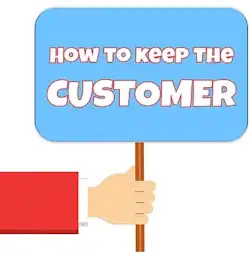Affiliate Marketing Churn Explained: Why Customers Quit and Jump Companies

Churn is a short term given to the frequency of turnover of customers and affiliates in any business.
One of the biggest concerns and frustrations for many affiliate marketing companies is this customer and affiliate ‘churn’.
It’s calculated as the percentage of customers who end their relationship with a company within a given period.
Typically, churn rates are calculated monthly, quarterly, or annually. Calculated by dividing the number of customers lost during a set period by the number of customers at the beginning of that period
For a simple example, if a company had a customer base of 500 at the beginning of the month and lost 50 customers during that month, its monthly churn rate would be 10%.
However, if you are an affiliate building your team it can be almost catastrophic if you lose more people than you can manage to enroll into your business!
In this post I’m going to dive into why people churn in affiliate marketing companies and dig out the hidden reasons why affiliates leave and why they repeat the same cycle.
You can spend a lot of time and effort getting customers and affiliates over the line – only to find they move on after a few months.
Part One Menu
Introduction: Understanding Affiliate Marketing Churn
Unrealistic Expectations Drive Customers Away
Poor Onboarding and Training Cause Confusion
Complicated Compensation Plans Frustrate Affiliates
Weak or Misaligned Products Kill Enthusiasm
The Role of Community in Affiliate Marketing Churn
Oversaturation Makes Success Feel Impossible
Trust Issues Damage Customer Loyalty
Short-Term Mindsets Reinforce the Churn Cycle
Conclusion: Why Customers Repeat the Behavior
Introduction: Understanding Affiliate Marketing Churn
Churn is one of the most pressing challenges in affiliate marketing, particularly when building strong and sustainable teams.
In this industry, churn refers to the number of customers—or affiliates—who end their relationship with a company within a given period.
While churn exists in every business, affiliate marketing companies often experience churn at unusually high rates.
Understanding the reasons behind this behavior is essential because solving churn requires diagnosing it first.
Unrealistic Expectations: The Root of Disappointment
One of the most common drivers of churn is unrealistic expectations.
Many people join an affiliate marketing company believing they will see instant results.
Social media, flashy recruitment pitches, and bold income claims often fuel this perception.
For example, an affiliate might hear success stories of individuals who achieved six-figure incomes in a few short months.
Convinced it will be easy, they sign up.
However, when reality sets in, disappointment follows.
Affiliate marketing requires effort, consistency, and patience.
There are no shortcuts.
When affiliates realize that quick wins are rare, they lose motivation. Instead of adjusting their expectations, they quit.
Then, still hungry for opportunity, they move to another company.
Unfortunately, the same cycle repeats, because the root issue—unrealistic expectations—remains unresolved.
Poor Onboarding: A Recipe for Confusion

Another significant reason for churn is poor onboarding.
Many companies spend energy on recruitment but neglect what happens after sign-up.
Without proper training, affiliates are left to figure things out on their own.
Imagine someone joining a program, only to receive a welcome email and a complicated dashboard with no guidance.
Within days, they feel lost.
They do not know how to market effectively, how to talk about products, or even how to access resources.
This confusion quickly turns into frustration.
Affiliates who feel unsupported are unlikely to stay.
Moreover, when onboarding fails, affiliates never truly integrate into the community.
As a result, they drift away, often without even notifying anyone.
Complex Compensation Plans: When Earnings Feel Out of Reach
Compensation plans in affiliate marketing are often complex, filled with terms like “binary trees,” “rank advancements,” or “volume points.”
For new affiliates, this can feel overwhelming.
If they cannot clearly understand how their efforts will translate into income, they disengage.
For instance, an affiliate might make a few sales and expect a reward, only to discover that they did not meet a hidden requirement.
This confusion creates mistrust.
They might feel the company is deliberately making it hard to succeed.
Eventually, they quit and move to another company that promises simpler or faster earnings.
However, they often encounter the same challenges there.
Product Misalignment: When Excitement Wears Off
Products are the backbone of affiliate marketing.
If affiliates do not believe in the products, their commitment fades.
Churn spikes when products are overpriced, lack quality, or fail to meet customer needs.
Consider an affiliate who promotes a supplement priced at double the retail value of similar items.
Initially, they might try to sell enthusiastically. However, after repeated customer objections, they become discouraged.
The same pattern plays out with digital products too.
If the training courses or software offered do not deliver real value, affiliates feel embarrassed to promote them.
Instead of fighting uphill, they leave in search of something they can proudly stand behind.
Weak Community and Culture: The Silent Churn Factor
Community is often overlooked but incredibly powerful.
Humans are wired for connection, and affiliates are no exception.
A strong culture of recognition, encouragement, and mentorship keeps people engaged.
Conversely, when community is weak, affiliates feel isolated.
For example, in some companies, only top earners receive attention while new affiliates feel invisible.
This creates a sense of exclusion.
Without recognition or a supportive environment, churn becomes almost inevitable.
Affiliates who leave often explain their decision by saying, “I didn’t feel like I belonged.”
Oversaturation: Too Many Voices, Too Few Ears
Affiliate marketing thrives on sales and recruitment, but markets can easily become saturated.
If too many affiliates push the same message using the same scripts, potential customers grow tired.
For affiliates entering later, opportunities appear scarce.
Picture a neighborhood where five different affiliates all pitch the same skincare line to the same group of people.
New affiliates struggle to find fresh prospects.
Discouraged by rejection after rejection, they conclude that success is impossible.
To escape the frustration, they leave.
Trust Issues: When Reputation Takes a Hit
Trust is fragile, and affiliate marketing companies sometimes damage it—intentionally or unintentionally.
If a company fails to deliver products on time, overcharges, or misrepresents benefits, customers and affiliates feel betrayed.
For instance, affiliates might read negative reviews online or hear stories of customers who had poor experiences.
Even if their own experience was fine, doubt creeps in.
To protect their reputation, they walk away.
Once trust is gone, rebuilding loyalty is almost impossible.
The Short-Term Mindset: Chasing Quick Wins
Finally, churn often reflects a short-term mindset.
Many affiliates join with the idea of making quick money rather than building a long-term business.
When instant results do not appear, they grow restless.
This mindset is reinforced by companies that highlight speed instead of sustainability.
As a result, affiliates hop from one company to the next, always chasing the illusion of fast wealth.
Unfortunately, this repeated behavior traps them in a cycle of quitting and restarting, preventing long-term success.
Conclusion: The Endless Cycle of Churn
Taken together, these factors—unrealistic expectations, poor onboarding, confusing pay, weak products, fragile community, market saturation, trust issues, and short-term thinking—create a churn cycle that repeats endlessly.
Affiliates leave because they feel frustrated, unsupported, or misled.
Then, they join another company, only to repeat the same mistakes.
Breaking this cycle requires companies to address churn at its roots.
However, before exploring solutions, it is vital to fully understand why churn happens.
Only then can affiliate marketing teams design strategies that truly improve retention.
Affiliate Retention Strategies: How to Keep Customers and Affiliates Longer
How to Reduce Churn and Retain Customers in Affiliate Marketing Teams
Learn proven steps to reduce churn in affiliate marketing.
Discover retention strategies to keep customers and affiliates engaged for the long term.
Part Two Menu
Introduction: How to Retain Customers Longer in Affiliate Marketing Teams
Set Realistic Expectations to Prevent Early Dropouts
Create Strong Onboarding Programs for New Affiliates
Simplify Compensation Plans to Build Confidence
Focus on High-Value Products That Inspire Loyalty
Build a Supportive Community and Recognition Culture
Encourage Creative Marketing to Avoid Oversaturation
Strengthen Trust Through Transparency and Service
Promote a Long-Term Mindset for Affiliate Success
The Compounding Power of Retention
Conclusion: Retention as a Competitive Advantage
Introduction: How to Retain Customers Longer in Affiliate Marketing Teams

While churn presents one of the toughest challenges in affiliate marketing, it is not impossible to manage.
Companies that succeed in retaining customers and affiliates enjoy more stable revenue, stronger teams, and healthier long-term growth.
Retention requires a deliberate strategy, however, and it begins with addressing the root causes of churn head-on.
Set Clear and Realistic Expectations
The first step is honesty.
Companies must set realistic expectations for new affiliates. Instead of promising fast riches, leaders should present affiliate marketing as a business that rewards consistent effort.
For example, training sessions can highlight stories of affiliates who grew steadily over several years rather than focusing only on overnight success tales.
This honesty prevents disappointment.
Affiliates who understand the journey from the start are less likely to give up when progress feels slow.
Moreover, by framing growth as a marathon instead of a sprint, companies cultivate affiliates with resilience.
Design Robust Onboarding Programs
Next, onboarding is critical.
Affiliates who feel guided and supported are far more likely to stay.
Companies can create step-by-step onboarding systems, complete with welcome calls, simple tutorials, and starter checklists.
Imagine how much more confident a new affiliate feels if they are paired with a mentor who checks in weekly during the first month.
This kind of structured support reduces confusion, builds confidence, and fosters connection.
Affiliates who know what to do and how to do it are much more motivated to keep going.
Simplify and Communicate Compensation Plans
Compensation plans must also be clear. Affiliates should easily see how their effort translates into income.
To achieve this, companies can provide interactive calculators, visual charts, and straightforward examples.
For instance, rather than burying details in a 40-page PDF, companies can explain, “Sell five starter kits this month, and you’ll earn X dollars.”
When affiliates understand exactly how to succeed, they remain engaged. Transparency builds trust, which directly combats churn.
Focus on High-Value Products
Products play a decisive role in retention.
Affiliates stay longer when they feel proud of what they promote.
This means companies must invest in products that solve real problems at fair prices.
For example, if a skincare line visibly improves customer results within weeks, affiliates gain confidence in selling it.
Additionally, continuous product innovation keeps excitement alive.
Limited-time launches, seasonal offerings, or bundled deals can reignite enthusiasm and give affiliates fresh reasons to talk about products.
Strengthen Community and Recognition

Beyond products and pay, affiliates crave connection.
Companies that build strong communities significantly reduce churn.
Online groups, live events, recognition programs, and ongoing training all contribute to a culture of belonging.
For example, celebrating milestones publicly—even small ones like “first sale made”—creates a ripple effect of encouragement.
Affiliates who feel seen and appreciated are less likely to quit.
Recognition is not just about big awards; it is about making people feel valued every step of the way.
Encourage Creative Marketing Approaches
Oversaturation can be reduced by teaching affiliates to market creatively.
Companies that train affiliates in personal branding, storytelling, and niche targeting empower them to stand out.
Instead of repeating generic scripts, affiliates can craft unique messages that resonate with their audiences.
For instance, one affiliate might build a following by documenting their personal journey with the products, while another might focus on educating a niche group like busy parents or fitness enthusiasts.
When affiliates succeed in differentiating themselves, they feel ownership, which strengthens loyalty.
Build Trust Through Transparency and Service
Trust is the glue that holds affiliates and customers together.
Companies must consistently deliver on promises, provide reliable customer service, and avoid hype.
Affiliates will remain loyal if they believe the company is ethical and dependable.
For example, quickly resolving a customer complaint not only retains that customer but also reassures affiliates that their reputation is safe.
By prioritizing integrity, companies strengthen long-term commitment.
Promote Long-Term Thinking
Finally, companies should encourage affiliates to think long-term.
Leaders can share case studies showing steady progress over years, not just months.
They can emphasize the compounding benefits of consistency, such as recurring income streams or team growth.
Affiliates who adopt this mindset are less likely to churn because they see beyond immediate setbacks.
They begin to view challenges as part of the journey rather than as reasons to quit.
The Compounding Power of Retention
When companies retain affiliates, the benefits compound.
Teams grow stronger, leaders spend less time replacing lost members, and morale rises.

Instead of constantly recruiting to replace those who quit, leaders can focus on developing skills, building culture, and expanding reach.
Moreover, retention creates momentum.
Affiliates who stay longer bring stability, attract more recruits, and deepen customer loyalty.
This stability sets the foundation for sustainable success in the competitive world of affiliate marketing.
Conclusion: Retention as a Growth Strategy
Churn may always exist to some degree, but companies that prioritize retention gain a powerful advantage.
By setting realistic expectations, investing in onboarding, simplifying pay, improving products, building community, supporting creativity, and nurturing long-term thinking, affiliate marketing companies can transform churn from a persistent obstacle into a manageable challenge.
Ultimately, retention is not just about keeping people from leaving.
It is about creating an environment where affiliates want to stay – because they feel supported, valued, and confident in their future.
Why A Downline Builder Fails – How to Make Them Work
Why Most Affiliate Marketers Fail But 5% Achieve Lasting Success
*This post may contain clickable affiliate links*

